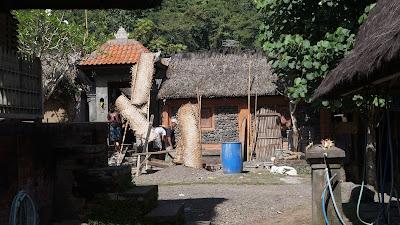Last stop,
Sideman, a small town ‘way up in the mountains of Bali. The fastboat from
Nusa Lembongan left me on a beach in Sanur where my friend and a taxi met me. The
driver got lost a time or two trying to find Sideman and blamed it on the fact
that he was new to the job. I’m not so sure I believe that. A short distance
from town we had a room rented in an establishment that had an infinity pool,
not my ideal but not bad on a hot day. We were surrounded by rice paddies,
gardens, mountains and exotic wild flowers. That’s more my style.
That afternoon, we wandered
into what I think was the village and turned down a pathway that ran along beside
walled compounds that smacked of old, old. I was reminded of the castles I
visited in other countries and wondered if defense had anything to do with it.
Around a turn or two we came across building where people were processing rice
and stopped to watch as they poured sacks of it into hoppers. The bran was
blown out a window and the rice came out between what seemed like small
millstones, nice and white, where an open bag waited. We watched, took a few
photos, got suckered out of a few rupiahs, then moved on.
Our little
alleyway took us out to the main road with rice fields on both sides. I fell in
love on the spot. The paddies were more or less in rectangles, though some were
contour to the shape of the slope, and they were in different stages of the
growing process.
I’ve been
asking people about the growing of rice and it goes a little like this: A field
can be harvested three, maybe four times a year and must be replanted after
each harvest. In the beginning, the young plants are the most beautiful shade
of green, very bright. It’s like a grass and grows pretty tightly together so I
imagine weeding isn’t such a big issue. When it starts going to seed, the birds
are deterred by all manner of cloth, clothing, even plastic bags tied to bamboo
poles. Then the rice grass is cut, bundled, and carried out on the heads or
shoulders of workers, on motor scooters, and any other way it can be
transported but seldom by automobile, it seems. It is then left out to dry, the
seed is knocked off and into the hopper it goes, if one is lucky enough to have
one available. I’ve seen people with big piles of rice on blankets turning it
over and over with whatever tool is available, once even a cooking pot. After
harvest, the plot is burned, then fertilized, the water is let back in and more rice
is planted. There are little waterways everywhere, often concrete,
and I was told the water comes from springs in the mountains. I’ve been fascinated with the process since
landing in Bali and am grateful to my travel partner for booking us in the midst of
it.
We did find
the water temple, ate lunch there, then turned back. Finding Sideman after all
that was a challenge. Once in a while
I’d see something familiar, but mostly I think Eric was just following his nose
because there were very few directional signs. As we got close we stopped to
ask a lot, got waved on this way, that way, and finally rolled into out villa
just before dark.


















































